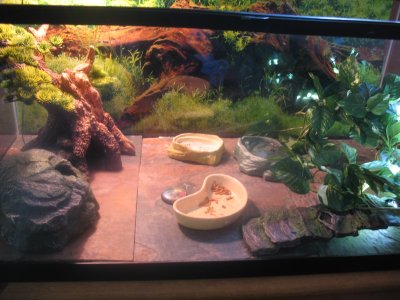When creating your gecko's new home be sure to have these items:
- 10 gallon Enclosure
- Lid
- Hide
- Water Dish
- Food Dish
- Thermometer & Hydrometer
- Climbing Branch or Rock
- Heating Pad (recommended)
- Heat Lamp
- Basking Bulb
- Nighttime Heat Lamp (if needed)
- Shed Box
- More Climbing areas or decor plants (optional)
These are all required for setting up your new enclosure. The Vivarium is the most important
part of all this! RULE OF THUMB: One gecko to a ten gallon vivarium. Although it is ok to have
two juvenile geckos in a ten gallon as long as they both have separate hides. The Hide is used for the
geckos themselves to be able to get away from the stress and to re cooperate, also they are nocturnal so
don't be surprised if your gecko spends most of his time in there. Next is the water dish which must
be changed and cleaned everyday to insure fresh and clean water. The food bowl can be used for
things like: Superworms, mealworms, or pellets. (I would not suggest putting crickets in there for
they might jump out.) When getting a food dish, using something natural looking is ok, but you may
also use something like a small tin cat dish. I use these so that the insects cannot crawl out! (Helps a
lot when you have sand substrate!) Next is the thermometer & hydrometer. This will help you
determine the exact temperature you need for heat and humidity inside the enclosure. A Climbing
Branch or rocks can be used wherever you would like, but is most useful in the basking area for your
gecko. Providing these will insure better exercise and enrichment for them. Heating Pads are
recommended on the bottom of your enclosure to help your gecko digest his food better, and better
prevent impaction. Although you can also place a heating pad on the side of the tank. A basking bulb
is needed, for your leopard gecko is cold blooded and cannot heat himself. Place the heat lamp above
the basking area. The shed box is also important because, not only does it provide another hide away,
but helps your gecko shed better. When placing the shed box inside the enclosure be sure to keep that
area moist all the time with either paper towels or moss. Finally you may add a background to
enhance the beauty of the tank and also plant decor and more climbing areas for your gecko to
enjoy!
My Own Geckos
Some Ideas




